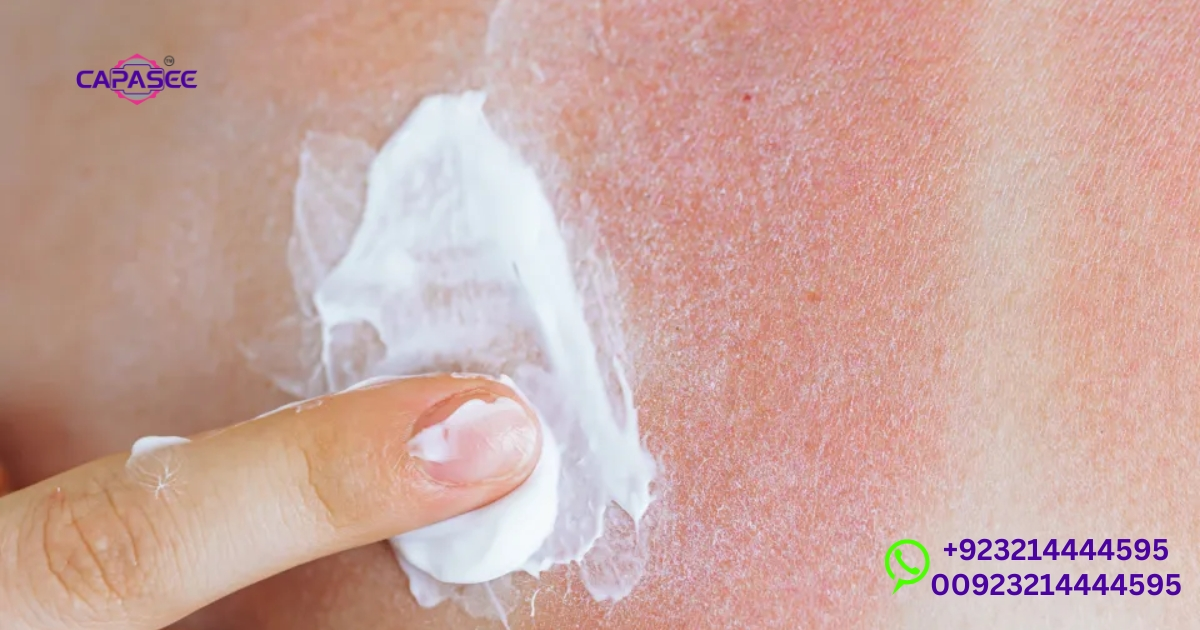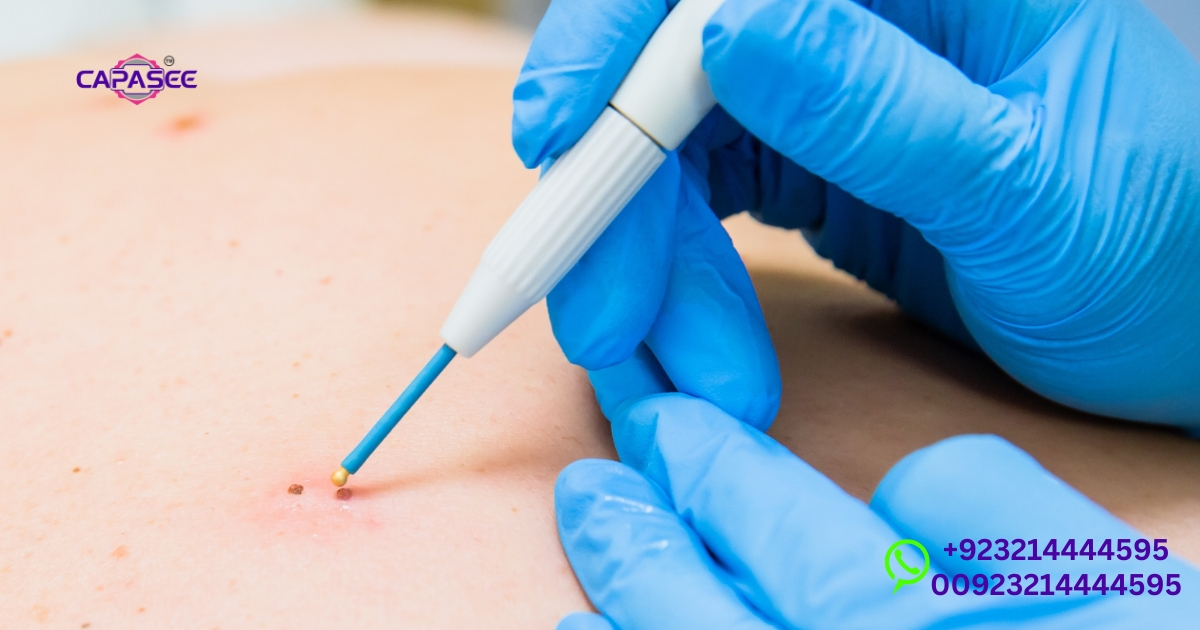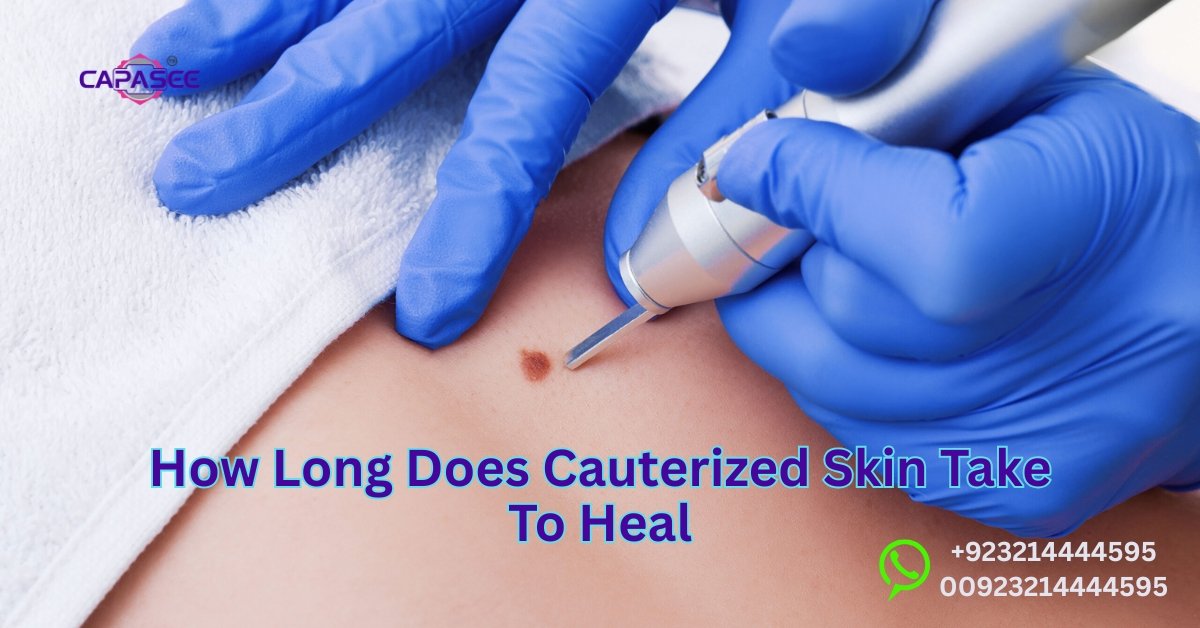You may not know, especially if you have undergone a cauterization procedure recently, how long it will take to heal. The waiting game and uncertainty can be very frustrating, particularly when you are willing to go back to what you used to do. Be it a small spot or otherwise, the healing process may seem like a gradual process. You would like to know when you are going to feel like yourself again.
This post will take you through the stages of healing of cauterized skin and the factors that may affect the duration. You will find your answers to your questions and some tips to make the process faster, so that you can take better care of your skin and forget all the doubts. Continue reading to find out all you should.
How Long Does Cauterized Skin Take To Heal? A Guide by Capasee
The wound healing process of cauterized skin takes different times according to the depth and the place where such a procedure is done. The skin wound healing process usually takes 2 to 3 weeks before showing considerable improvement following cautery. The process will cause you to see how the scab is formed as the wound covers itself and shields against the outside factors. It is important to follow the instructions of cautery wound care in order to accelerate the healing process.
During the healing, you will undergo the healing process of cauterized wounds. The period when the scab falls off takes place in the first 2 weeks in most cases. This will be followed by further healing of your skin. The post cauterization skin care is necessary to prevent infection and to help in healthy healing. Another thing to do is to adhere to the skin cauterization recovery timeline to keep track of your progress.
Typical Healing Stages After Skin Cautery
When the skin has been treated with cauterization, the healing process is predictable. The initial level is the scab formation, whereby a crust is formed on the cauterized region to shield it against infections. The healing process starts immediately and the healing duration of the cauterized wounds may take time based on the type of cautery used. The process of healing skin lesions through cautery normally requires a period of 2 to 3 weeks before it registers any significant improvement.
During the second stage, the scab peels off slowly, leaving new skin beneath. At this stage, one must adhere to the after cauterization skin care measures, such as Vaseline or antibiotic ointment. The timing of pressure application to bleeding and removing the dressing must be well taken care of to prevent infection. Watch out in case of infection in the form of redness, swelling and pus, since they will slow down the healing like a graze.
Expected Skin Cauterization Recovery Period Explained
Depending on the depth and size of the cauterization, the healing period in cauterized skin may vary. Initial recovery is usually ended when the skin heals 2 to 3 weeks after cauterization. The healing of a cauterized skin will take different times, which are based on different factors, including your health, the area to be treated, and the care you offer. Skin scraping and cautery heal slowly in deeper wounds and the healing may be completed in the course of several weeks.
At this stage, do not use friction protection on the wound and do not pick the scab. It is aimed at allowing the skin to recover, without any damage, which can slow the process of healing. Cautery aftercare Pain management can involve over the counter pain relievers, although you should always take the advice of your doctor to ensure a hassle free recovery.
What to Expect After Skin Cauterization: Timeline and Symptoms
You will have several symptoms after cauterization. Firstly, a slight pain and swelling in the area attended to can occur. This is normal and will normally resolve following the local anesthetic effect wears off. The scab formation will be visible in the coming few days and it serves as a protective layer. More importantly, it is important to maintain the area clean to prevent infection that may delay the healing process of skin wounds after cautery.
By week two, the scab will have begun to loosen and the skin cauterization recovery process will have begun to display some progress. Do not subject the area to too much moisture or direct friction. The healing process will be ongoing on the treated part; however, be patient. The stages of wound healing following cauteries are slow and with the right care, your cauterized skin will only have an optimal outcome.
| Stage | Description | Duration |
| Initial Healing | Formation of a scab to protect the wound | 1-2 weeks |
| Mid Healing | Scab loosens, and fresh skin begins to show | 2-3 weeks |
| Final Healing | Skin fully heals, and the area returns to normal | 3-4 weeks |
Skin scraping and cautery are also a wound that takes time to heal; however, with appropriate care, you will notice some improvements. Take note of the cautery wound care directions and never subject the injured part to extra stress.
You May Also Read This Blog: When To Wash Face After Cautery
Expert Tips on How to Care for Cauterized Skin to Speed Up Healing

The skin that has been cauterized needs special care to ensure that the process takes a shorter time to heal. Take the precautions given in follow up care of the cautery wounds, maintain the site clean and dry. Rub Vaseline or antibiotic ointment on the affected skin to discourage infection and promote healing. Always remember not to pick the scab, as this is known to decelerate the healing of the skin wound once cauterized.
Moreover, it is necessary to avoid additional irritation by covering the skin with friction and pressure. Cauterized wounds normally take 2 to 3 weeks to heal. At this period, you are to observe the site for signs of infection risk, including redness, swelling, and pus. These tips will assist in ensuring that the skin lesion cautery healing process is a smooth one.
Cauterized Wound Care Tips from Capasee Electro Medical Engineering
Having proper wound care is a must to be able to manage your cauterized skin to ensure a successful recovery. To minimize the chance of infection, it may help to keep the area clean and put a sterile dressing on it. Also, apply a local anesthetic in case you have pain. To protect this place, Vaseline or antibiotic ointment should be applied and to encourage the healing process of the skin scraped and cauterized.
When the dressing is concerned, watch how soon to take off the dressing during the skin cauterization recovery timeline. Another tip is to not touch a dressing unless directed to do so by your healthcare provider and to not interrupt the recovery process. Regular attention during the wound healing process post cautery is one of the important factors for a healthy recovery.
Using Vaseline for Cauterized Wound Healing: Benefits and Best Practices
Vaseline has an important role in the cauterized skin repairing time, as it keeps the wound wet and this could speed up the healing process. Its application controls the formation of the scabs and minimizes the chances of scarring. It also covers the wound against external bacteria, which minimizes the chances of infection. Apply a thin coat of Vaseline or antibiotic ointment to the area once a day to ensure the best environment for healing.
Moreover, the way of taking care of cauterized skin is as significant as Vaseline usage. Excessive friction or moisture should be avoided since this may slow down the healing process of the skin lesion cautery. It is important to keep the wound out of any unwarranted distress in order to have a smooth healing process, particularly in the first two weeks when the skin is sensitive.
How to Prevent Scars and Manage Scab Healing After Cauterization
It is important to control the formation of scabs to avoid scarring. Do not scratch the scab, because it is a natural component of the healing process of skin wounds after the procedure of cautery. Let it drop away on its own so that the skin can heal up under the skin. Moreover, you should not expose the wound to direct sunlight or extreme conditions, as this might cause more noticeable scars.
Skin care after the process of cauterization entails moisturization and maintaining the site. These are just a few things that you can do to minimize the risk of permanent marks. In case of too much pain after cauterization or any signs of infection risk, consult a medical worker, who will instruct you on the recovery of the skin 2 to 3 weeks after cauterization.
Healing Process and Potential Complications After Skin Cauterization

Cauterized skin healing is done in phases; the first phase concentrates on scab development. The cautery wound care instructions should be followed during this stage. The healing of skin wounds after cautery requires approximately 2 to 3 weeks and each day, there is an increment in healing. Disclean the location to prevent complications.
Unless the healing process is as expected, it can also result in complications, including infection. Infection is indicated by redness, swelling and pus. In case of the emergence of such symptoms, consult a doctor as soon as possible to prevent additional problems. These issues can be avoided with the application of proper after cauterization skin care.
Read More: Our Products
Curettage and Cautery Healing Duration: What Patients Need to Know
The number of days it takes the cauterized wounds to heal depends on the depth and size of the treatment. Skin scraping and cauteries are normally healed within 2 to 3 weeks, though cauterizations deep into the skin can take longer. The skin cauterization recovery schedule assists patients in knowing what to expect during each phase of the healing process.
The most important thing to do is to watch the signs of the risk of infection and adhere to all aftercare recommendations during recovery. Vaseline or antibiotic ointment will help in healing. The skin lesion cautery healing will be progressive, with the scab naturally exfoliating.
Recognizing Symptoms of Infection After Cautery and When to Seek Help
The healing of cauterized skin can be slowed down by infections. Observe such signs as swelling, redness, or pus. Such symptoms are the sign of infection and may require pain management following cautery. Keeping such signs, one should seek medical assistance.
Wound friction protection is also essential in the process of wound healing in order to avoid infection. Adhere to all the precautions of the wound care guidelines to minimize the risks and prevent any complications, such as scarring. Early attack is also important in healthy recovery.
Proven Methods to Support Wound Healing After Cauterizing
When taken care of, cauterized skin would heal better. One should not pick the scab because this may delay the healing process. Frequently apply Vaseline or antibiotic ointment to keep the wound moist. This also aids in preventing infection and a faster recovery.
The recovery schedule of the skin cauterization is crucial to the correct healing process. Ensure that the area being treated is not exposed to too much moisture and friction. Bleeding can also be controlled by applying pressure in case of bleeding during the healing process.
Frequently Asked Questions
What is the fastest way to heal a cauterized wound?
Clean the area, use Vaseline or antibiotic ointment and never pick the scab in order to heal faster.
What does skin look like after being cauterized?
The skin can also be red with a scab coming in as it cures and some mild swelling can take place.
How long does it take for skin to heal after cauterization?
Cauterized skin requires 2 to 3 weeks to completely heal, with scabs falling off in the process.
What are the do’s and don’ts after cauterization?
Do keep the place clean and moist. Do not pluck the scab or subject the wound to friction.
What should you avoid after cauterization?
Excess moisture, friction and scratching at the treated site should also be avoided to facilitate proper healing.
Final Thoughts
The healing of cauterized skin is greatly determined by the depth of the exposure and adequate care taken. The healing of the skin usually takes 2 to 3 weeks, with scabs falling off in the process. The most effective recovery involves following the instructions for cautery wounds, applying Vaseline or antibiotic ointment, and not picking the scab. You can encourage the healing process by preventing friction and moisture in the area and complications. It is important to seek medical attention whenever you observe any signs of infection or any other abnormal symptoms.

